修辞格的翻译word 版
- 格式:doc
- 大小:55.50 KB
- 文档页数:7

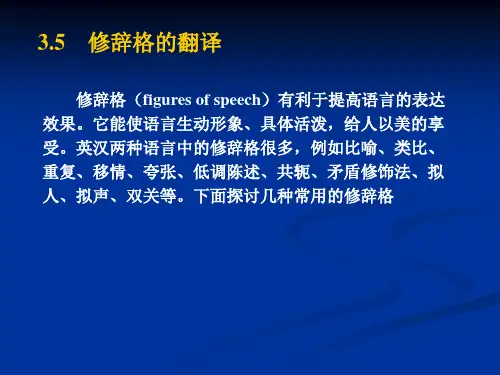
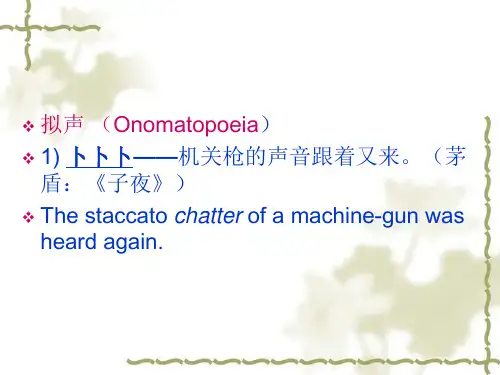
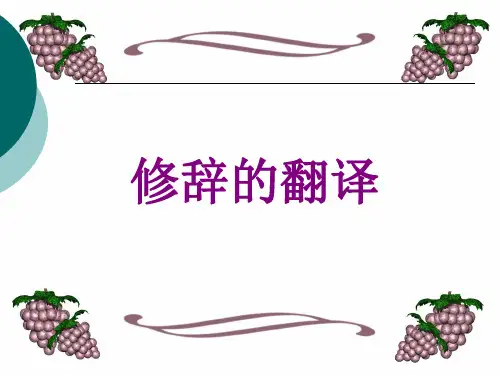
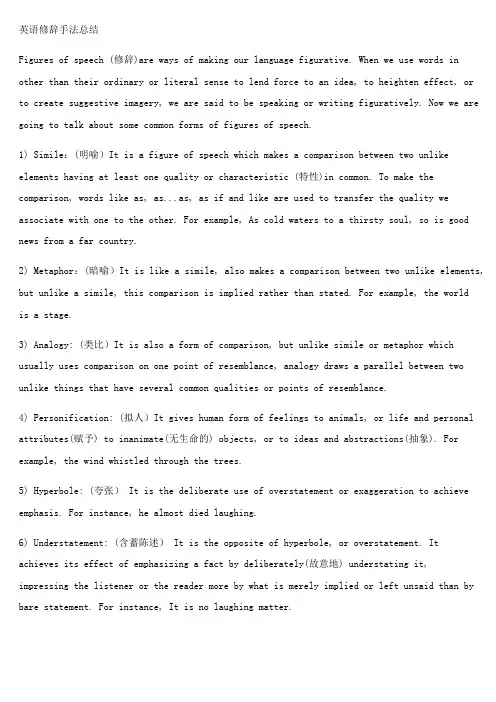
英语修辞手法总结Figures of speech (修辞)are ways of making our language figurative. When we use words in other than their ordinary or literal sense to lend force to an idea, to heighten effect, orto create suggestive imagery, we are said to be speaking or writing figuratively. Now we are going to talk about some common forms of figures of speech.1) Simile:(明喻)It is a figure of speech which makes a comparison between two unlike elements having at least one quality or characteristic (特性)in common. To make the comparison, words like as, as...as, as if and like are used to transfer the quality we associate with one to the other. For example, As cold waters to a thirsty soul, so is good news from a far country.2) Metaphor:(暗喻)It is like a simile, also makes a comparison between two unlike elements, but unlike a simile, this comparison is implied rather than stated. For example, the worldis a stage.3) Analogy: (类比)It is also a form of comparison, but unlike simile or metaphor which usually uses comparison on one point of resemblance, analogy draws a parallel between two unlike things that have several common qualities or points of resemblance.4) Personification: (拟人)It gives human form of feelings to animals, or life and personal attributes(赋予) to inanimate(无生命的) objects, or to ideas and abstractions(抽象). For example, the wind whistled through the trees.5) Hyperbole: (夸张) It is the deliberate use of overstatement or exaggeration to achieve emphasis. For instance, he almost died laughing.6) Understatement: (含蓄陈述) It is the opposite of hyperbole, or overstatement. Itachieves its effect of emphasizing a fact by deliberately(故意地) understating it,impressing the listener or the reader more by what is merely implied or left unsaid than by bare statement. For instance, It is no laughing matter.7) Euphemism: (委婉) It is the substitution of an agreeable or inoffensive(无冒犯) expression for one that may offend or suggest something unpleasant. For instance, we refer to "die" as " pass away".8) Metonymy (转喻)It is a figure of speech that has to do with the substitution of the mane of one thing for that of another. For instance, the pen (words) is mightier than the sword (forces).9) Synecdoche (提喻) It is involves the substitution of the part for the whole, or thewhole for the part. For instance, they say there's bread and work for all. She was dressedin silks.10) Antonomasia (换喻)It has also to do with substitution. It is not often mentioned now, though it is still in frequent use. For example, Solomon for a wise man. Daniel for a wise and fair judge. Judas for a traitor.11) Pun: (双关语) It is a play on words, or rather a play on the form and meaning of words. For instance, a cannon-ball took off his legs, so he laid down his arms. (Here "arms" has two meanings: a person's body; weapons carried by a soldier.)12) Syllepsis: (一语双叙) It has two connotations.In the first case, it is a figure by which a word, or a particular form or inflection of a word, refers to two or more words in the same sentence, while properly applying to or agreeing with only on of them in grammar or syntax(句法). For example, He addressed you and me, and desired us to follow him. (Here us is used to refer to you and me.)In the second case, it a word may refer to two or more words in the same sentence. For example, while he was fighting , and losing limb and mind, and dying, others stayed behind to pursue education and career. (Here to losing one's limbs in literal; to lose one's mindis figurative, and means to go mad.)13) Zeugma: (轭式搭配) It is a single word which is made to modify or to govern two or more words in the same sentence, wither properly applying in sense to only one of them, orapplying to them in different senses. For example, The sun shall not burn you by day, nor the moon by night. (Here noon is not strong enough to burn)14) Irony: (反语) It is a figure of speech that achieves emphasis by saying the opposite of what is meant, the intended meaning of the words being the opposite of their usual sense. For instance, we are lucky, what you said makes me feel real good.15) Innuendo: (暗讽) It is a mild form of irony, hinting in a rather roundabout (曲折)way at something disparaging(不一致) or uncomplimentary(不赞美) to the person or subject mentioned. For example, the weatherman said it would be worm. He must take his readings in a bathroom.16) Sarcasm: (讽刺) It Sarcasm is a strong form of irony. It attacks in a taunting and bitter manner, and its aim is to disparage, ridicule and wound the feelings of the subject attacked. For example, laws are like cobwebs, which may catch small flies, but let wasps break through.17) Paradox: (似非而是的隽语) It is a figure of speech consisting of a statement or proposition which on the face of it seems self-contradictory, absurd or contrary to established fact or practice, but which on further thinking and study may prove to be true, well-founded, and even to contain a succinct point. For example more haste, less speed.18) Oxymoron: (矛盾修饰) It is a compressed paradox, formed by the conjoining(结合) of two contrasting, contradictory or incongruous(不协调) terms as in bitter-sweet memories, orderly chaos(混乱) and proud humility(侮辱).19) Antithesis: (对照) It is the deliberate arrangement of contrasting words or ideas in balanced structural forms to achieve emphasis. For example, speech is silver; silence is golden.20) Epigram: (警句) It states a simple truth pithily(有利地) and pungently(强烈地). It is usually terse and arouses interest and surprise by its deep insight into certain aspects of human behavior or feeling. For instance, Few, save the poor, feel for the poor.21) Climax: (渐进) It is derived from the Greek word for "ladder" and implies the progression of thought at a uniform or almost uniform rate of significance or intensity,like the steps of a ladder ascending evenly. For example, I came, I saw, I conquered.22) Anti-climax or bathos: (突降)It is the opposite of Climax. It involves stating one's thoughts in a descending order of significance or intensity, from strong to weak, from weighty to light or frivolous. For instance, But thousands die, without or this or that, die, and endow(赋予) a college, or a cat.23) Apostrophe: (顿呼) In this figure of speech, a thing, place, idea or person (dead or absent) is addressed as if present, listening and understanding what is being said. For instance, England! awake! awake! awake!24) Transferred Epithet: (转类形容词) It is a figure of speech where an epithet (anadjective or descriptive phrase) is transferred from the noun it should rightly modify(修饰) to another to which it does not really apply or belong. For instance, I spent sleeplessnights on my project.25) Alliteration: (头韵) It has to do with the sound rather than the sense of words for effect. It is a device that repeats the same sound at frequent intervals(间隔) and since the sound repeated is usually the initial consonant sound, it is also called "front rhyme". For instance, the fair breeze blew, the white foam flew, the furrow followed free.26) Onomatopoeia: (拟声) It is a device that uses words which imitate the sounds made by an object (animate or inanimate), or which are associated with or suggestive(提示的) of some action or movementExplanation version1一、什么是修辞格修辞格(figures of speech)是提高语言表达效果的语言艺术。
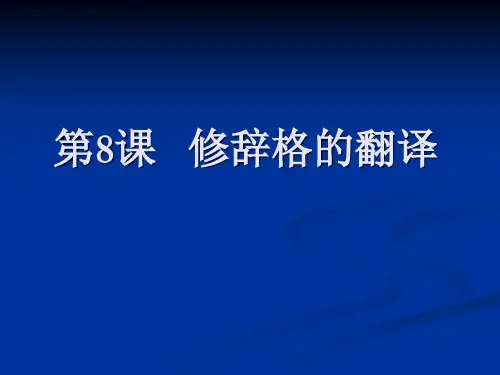
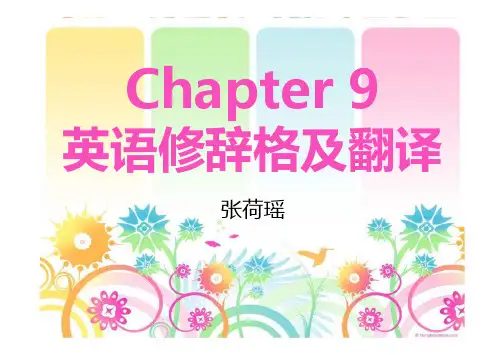
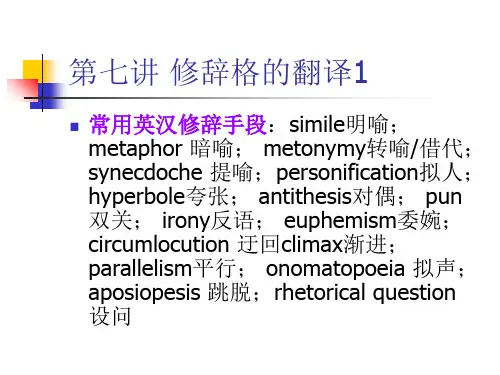
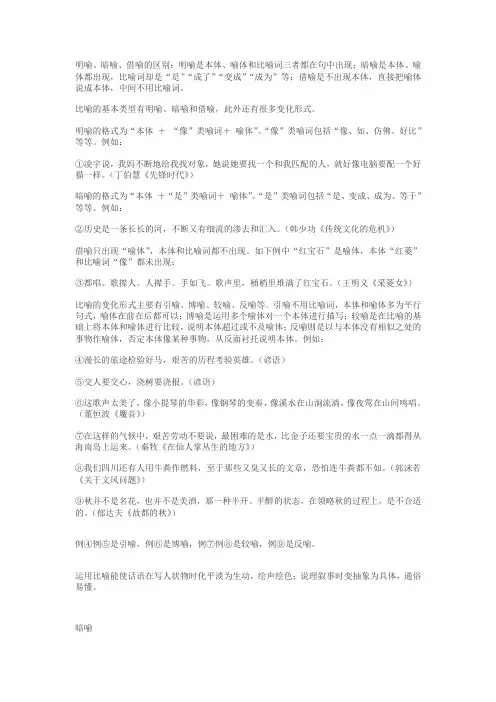
明喻、暗喻、借喻的区别:明喻是本体、喻体和比喻词三者都在句中出现;暗喻是本体、喻体都出现,比喻词却是“是”“成了”“变成”“成为”等;借喻是不出现本体,直接把喻体说成本体,中间不用比喻词。
比喻的基本类型有明喻、暗喻和借喻,此外还有很多变化形式。
明喻的格式为“本体+“像”类喻词+喻体”。
“像”类喻词包括“像、如、仿佛、好比”等等。
例如:①凌宇说,我妈不断地给我找对象,她说她要找一个和我匹配的人,就好像电脑要配一个好猫一样。
(丁伯慧《先锋时代》)暗喻的格式为“本体+“是”类喻词+喻体”。
“是”类喻词包括“是、变成、成为、等于”等等。
例如:②历史是一条长长的河,不断又有细流的渗去和汇入。
(韩少功《传统文化的危机》)借喻只出现“喻体”,本体和比喻词都不出现。
如下例中“红宝石”是喻体,本体“红菱”和比喻词“像”都未出现:③都唱。
歌撵人。
人撵手。
手如飞。
歌声里,桶梢里堆满了红宝石。
(王明义《采菱女》)比喻的变化形式主要有引喻、博喻、较喻、反喻等。
引喻不用比喻词,本体和喻体多为平行句式,喻体在前在后都可以;博喻是运用多个喻体对一个本体进行描写;较喻是在比喻的基础上将本体和喻体进行比较,说明本体超过或不及喻体;反喻则是以与本体没有相似之处的事物作喻体,否定本体像某种事物,从反面衬托说明本体。
例如:④漫长的旅途检验好马,艰苦的历程考验英雄。
(谚语)⑤交人要交心,浇树要浇根。
(谚语)⑥这歌声太美了,像小提琴的华彩,像钢琴的变奏,像溪水在山涧流淌,像夜莺在山间鸣唱。
(董恒波《魔音》)⑦在这样的气候中,艰苦劳动不要说,最困难的是水,比金子还要宝贵的水一点一滴都得从海南岛上运来。
(秦牧《在仙人掌丛生的地方》)⑧我们四川还有人用牛粪作燃料,至于那些又臭又长的文章,恐怕连牛粪都不如。
(郭沫若《关于文风问题》)⑨秋并不是名花,也并不是美酒,那一种半开、半醉的状态,在领略秋的过程上,是不合适的。
(郁达夫《故都的秋》)例④例⑤是引喻,例⑥是博喻,例⑦例⑧是较喻,例⑨是反喻。

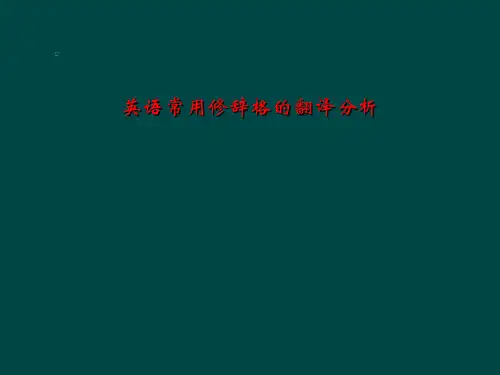
第8课修辞格的翻译Contents:相同点:分类和使用不同点:语言环境、美学观念不同,用不同修辞格表达同一概念,to eat like a horse, to work like a horse辞格分类:音韵修辞格结构修辞格语义修辞格辞格翻译分为三类:可译:同一辞格不可译:(涉及到不同文字字形结构或音韵)另辟奇径难译:转换辞格,意译原则:使原文音形义的修辞效果尽可能完美地传达出来翻译方法:直译意译 (转换修辞格转换喻体引申词义增加用词) 弥补classification:音韵修辞格:(Phonetic Stylistic Devices)alliteration头韵, onomatopoeia拟声,assonance, rhyme脚韵结构/句法修辞格:(Syntactical Stylistic Devices)repetition反复, chiasmus回文, parallelism排比, antithesis对偶, question and answer 设问,rhetoric question反问, anastrophe倒装语义修辞格:(Lexical Stylistic Devices)metaphor暗喻, simile明喻, metonymy转喻, personification拟人, irony反语, hyperbole 夸张, understatement缩小, allusion典故, euphemism讳饰, contrast, paradox/oxymoron精警, transferred epithet移就, pun双关, zeugma拈连, parody仿拟1.音韵修辞格:(Phonetic Rhetorical Devices)alliteration头韵,onomatopoeia拟声rhyme脚韵1. 1 Alliteration (头韵)It refers to the appearance of the same initial consonant sound in two or more words, such as “proud as a peacock" and “blind as a ba t".Alliteration is often used in poetry to give emphasis to words that are related in meaning:Wherefore feed, and clothe, and save,From the cradle to the grave,Those ungrateful drones who wouldDrain your sweat—nay, drink your blood?-Percy Bysshe ShellyAlliteration is sometimes used in prose for the same effect-to join two or more related words:I see also the dull, drilled, docile, brutish masses of the Hun soldiery plodding on likea swarm of crawling locusts.The Russian danger is therefore our danger,…just as the cause of any Russian fighting for his hearth and home is the cause of free men and free peoples in every quarter of the globe.-—--—-from Winston Churchill's speech on Hitler’s invasion of the Soviet Union in 1941。
第8课修辞格的翻译Contents:相同点:分类和使用不同点:语言环境、美学观念不同,用不同修辞格表达同一概念,to eat like a horse, to work like a horse辞格分类:音韵修辞格结构修辞格语义修辞格辞格翻译分为三类:可译:同一辞格不可译:(涉及到不同文字字形结构或音韵)另辟奇径难译:转换辞格,意译原则:使原文音形义的修辞效果尽可能完美地传达出来翻译方法:直译意译(转换修辞格转换喻体引申词义增加用词) 弥补classification:音韵修辞格:(Phonetic Stylistic Devices)alliteration头韵, onomatopoeia拟声,assonance, rhyme脚韵结构/句法修辞格:(Syntactical Stylistic Devices)repetition反复, chiasmus回文, parallelism排比, antithesis对偶, question and answer 设问,rhetoric question 反问, anastrophe倒装语义修辞格:(Lexical Stylistic Devices)metaphor暗喻, simile明喻, metonymy转喻, personification拟人, irony反语, hyperbole夸张, understatement缩小, allusion典故, euphemism讳饰, contrast, paradox/oxymoron精警, transferred epithet移就, pun双关, zeugma拈连, parody仿拟1.音韵修辞格:(Phonetic Rhetorical Devices)alliteration头韵,onomatopoeia拟声rhyme脚韵1. 1 Alliteration (头韵)It refers to the appearance of the same initial consonant sound in two or more words, such as “proud as a peacock” and “blind as a bat”.Alliteration is often used in poetry to give emphasis to words that are related in meaning:Wherefore feed, and clothe, and save,From the cradle to the grave,Those ungrateful drones who wouldDrain your sweat—nay, drink your blood?—Percy Bysshe ShellyAlliteration is sometimes used in prose for the same effect—to join two or more related words:I see also the dull, drilled, docile, brutish masses of the Hun soldiery plodding on like a swarm of crawling locusts.The Russian danger is therefore our danger, …just as the cause of any Russian fighting for his hearth and home is the cause of free men and free peoples in every quarter of the globe.------from Winston Churchill’s speech on Hitler’s invasion of the Soviet Union in 1941.翻译:增加用词Then Lieutenant Grub launched the old recruiting routine.See,save and serve!于是.格拉布上尉开始说起招兵的老一套了:见见世面,攒点钱,为国家出点力!此例主要修辞手法是Alliteration(头韵)。
See, save and serve在用作不及物动词时。
宾语实际上隐含在动词后面.译成汉语时需要把它表达出来。
因此译文中分别增加了世面、钱、国家三个词。
1.2 RhymeWhen the cat's away, the mice will play.猫儿不在,鼠儿作怪。
秦时明月汉时关,万里长征人未还。
The age-old moon still shines o'er the ancient Great Wall,But our frontier guardsmen have not come back at all.饭来张口,衣来伸手have only to open one's mouth to be fedand hold out one's hands to be dressed----- lead an easy life1.3 onomatopeia (拟声)A hammering clatter of hoofs beating the hard road.“得、得、得”,坚硬的路面上响着接连不断的马蹄声。
White jagged lightning, followed by the brazen clash and deep rumble of thunder.”天空中闪过一道成V形的白色闪电,紧接着传来一声霹雳,然后是深沉的隆隆雷声。
把人或动物发出的声音如实加以描摹的修辞方法称为拟声。
汉英都有拟声,但是区别较大。
一些英语动词和名词融音义于一体,本身就具备拟声的特点;而汉语则采用直接描摹声音的拟声词。
2. 结构修辞格:(Syntactical RhetoricalDevices) repetition反复parallelism排比antithesis对偶question and answer 设问rhetoric question反问anastrophe倒装apostrophe 呼告2.1 反复(Repetition)根据表达的需要,重复使用同一语句或词语的修辞手法叫反复。
可以突出感情,分清层次,增添旋律美,加强节奏感。
April, April, Laugh thy girlish laughter. (W. Watson)四月呀四月,笑吧,姑娘般地笑吧。
A thin man in a thin overcoat watched them out of thin, emotionless eyes.一个骨瘦如柴、衣服单薄、双目失神的男子注视着他们。
It was a day as fresh as grass growing up and clouds going over and butterflies coming down can make it. It was a day compounded from silence of bee and flower and ocean and land.绿草萋萋,白云冉冉,彩蝶翩翩,这日子是如此清新可爱。
密封无言,春花不语,海涛声咽,大地音沉,这日子是如此安详。
连用四字格和连词2.2 排比(parallelism )排比就是连续使用三个或三个以上结构相同或相似的句子或词组,起到增强语言的感染力和气势的效果。
直译保留原文排比的感染力和气势,译文一般采取排比的形式。
1) V oltaire waged the splendid kind of warfare. The war of thought against matter, the war of reason against prejudice,the war of the just against the unjust.2) He conquered violence by a smile, despotism by sarcasm, infallibility by irony, obstinacy by perseverance, ignoranceby truth.3) Studies serve for delight, for ornament, and for ability.4) Doubt thou the stars are fire;Doubt that the sun doth move;Doubt truth to be a liar;But never doubt I love.5)我不相信天是蓝的;我不相信雷的回声;我不相信梦是假的;我不相信死无报应。
2.3对偶(Antithesis)对偶要求上下两句在结构上相同或相似,字数相等或基本相等。
Beauty, strength, youth, are flowers but fading seen;Duty, faith, love, are roots, and ever green.(from a sonnet by George Peele)美貌、体力、年轻,就像花朵,终将衰尽;义务、信念、爱情,就像树根,万古长青。
樱花红陌上,柳叶绿池边。
(《周恩来诗选<春日偶成>》The pathways red with cherry blossoms;The lakeside green with willow leaves.2.4 设问(question and answer)设问就是用自问自答的形式来达到增强语气、吸引注意力的效果,并可以起到承上启下的作用,常用直译。
例如:1)Shall I compare thee to a summer's day? Thou art more lovely and more temperate.2) To what is the increase of population? In part, I suppose, to a general increase in prosperity.3) 既然小李已经向他道歉,他应该怎么做呢?当然是原谅小李了。
2.5 反问(rhetorical question )反问指有意提出不答自明的问题,以达到加强预期的效果,通常直译。
例如:1) It is possible to run a primitive society without a penal code; why not a cultured society?2) Can't you just leave me alone?3) 你的心过去是苦的,你怎么能闻到红叶的香味?4)谁愿意和手上有同志鲜血的人握手呢?2.6 Anastrophe 倒装Fine and sunny it was when we started on our way. 我们动身那天,天气晴朗,阳光灿烂。